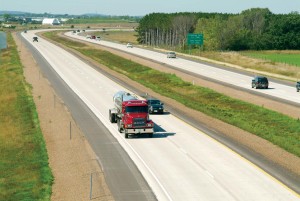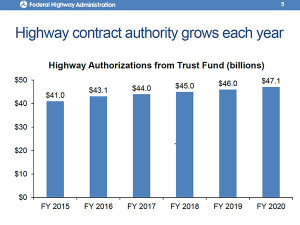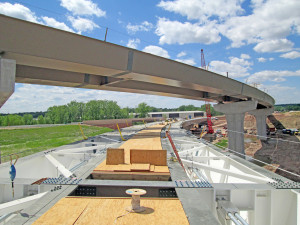FAST Act Provides 5-Year Transportation Funding
 For the first time in a decade, federal transportation funding has a road map to the future. It’s called FAST Act.
For the first time in a decade, federal transportation funding has a road map to the future. It’s called FAST Act.
In cooperation with the Institute of Transportation Engineers (ITE) and the Federal Highway Administration (FHWA), Ayres Associates’ Waukesha, Wisconsin, office recently hosted a webinar that took a 360-degree tour of the FAST Act legislation that for the first time in 10 years provides a multi-year federal plan for transportation appropriations and policy. The plan, approved by Congress and signed by President Obama in December, commits to steadily raising federal funding levels over each of the next five years.
The legislation includes provisions to accelerate project delivery and cut costs through flexibility in design requirements, place more emphasis on environmental and community impacts of projects, and establish a new program specifically aimed at speeding up the movement of freight along key routes.
 FAST (Fixing America’s Surface Transportation) Act raises Trust Fund highway authorizations from $41 billion in fiscal 2015 to $43 billion in 2016 and then steps up funding about $1 billion each year through 2020, when outlays will be at $47.1 billion. For the past decade, transportation expenditures have been appropriated one year at a time, leaving states less than certain about the availability of funds to cover projects requiring years to implement.
FAST (Fixing America’s Surface Transportation) Act raises Trust Fund highway authorizations from $41 billion in fiscal 2015 to $43 billion in 2016 and then steps up funding about $1 billion each year through 2020, when outlays will be at $47.1 billion. For the past decade, transportation expenditures have been appropriated one year at a time, leaving states less than certain about the availability of funds to cover projects requiring years to implement.
Fast Act’s key provisions are described in this U.S. Department of Transportation/FHWA summary. Our take on it is below.
Accelerating Project Delivery: The Act codifies the FHWA’s Every Day Counts initiative, which identifies and deploys proven innovations that reduce red tape and costs through practical, reasonable, environmentally sustainable procedural improvements. The Act also:
- Clarifies the roles of various federal regulators in the environmental review process.
- Expands a public dashboard providing transparency in the transportation project review process.
- Emphasizes the use of exemptions and expedited environmental reviews for reconstruction after disasters.
- Extends an exemption under which environmental review of post-1950 concrete bridges can be addressed as a group instead of as independent reviews.
- Authorizes taking nesting swallows in at-risk bridges
Cost Savings Via Flexibility in Design Guidance: FAST Act will consider both the AASHTO Highway Safety Manual and the NACTO Urban Street Design Guide. An example of a possible impact of this flexibility would be approval of a travel lane narrower than 12 feet. In a large city’s downtown, fitting a 12-foot travel lane plus a bike lane might be impossible without knocking down buildings or eliminating sidewalks, but 10- or 11-foot traffic lanes may make a multimodal approach feasible. FAST Act will make the process of getting approval for that sub-12-foot lane less arduous than the traditional “design exception” process currently in place for such an approval.
 Emphasis on Environmental and Community Impacts: Wording has been strengthened in FAST Act regarding the integration of environmental, contextual, and multimodal accommodations in designs on the National Highway System. Previously federal guidance was that designs “may take into account” the constructed/natural environment; scenic, aesthetic, environmental, historic, community, and preservation impacts; and access for other travel modes. Under FAST Act, designs “shall consider” these factors, which already have gained a lot of traction among local jurisdictions.
Emphasis on Environmental and Community Impacts: Wording has been strengthened in FAST Act regarding the integration of environmental, contextual, and multimodal accommodations in designs on the National Highway System. Previously federal guidance was that designs “may take into account” the constructed/natural environment; scenic, aesthetic, environmental, historic, community, and preservation impacts; and access for other travel modes. Under FAST Act, designs “shall consider” these factors, which already have gained a lot of traction among local jurisdictions.
New Program Aimed at Speeding Movement of Freight: This apportionment averaging $1.2 billion per year – along with competitive grants and loans – is for construction, operational improvements, freight planning, and performance measures on the interstate system and the 41,000-mile National Highway Freight Network. States, large metropolitan planning organizations, tribes, and localities can apply for the grants and loans. The freight program aims to improve intermodal freight connections, urban freight route segments near the sources and end points of the freight routes, and highway capacity improvements in known bottleneck areas. Among the possible freight solutions are dedicated truck-only lanes. Grant applications for fiscal 2016 freight projects are due April 14, and the grant program is described here.

Post a comment: